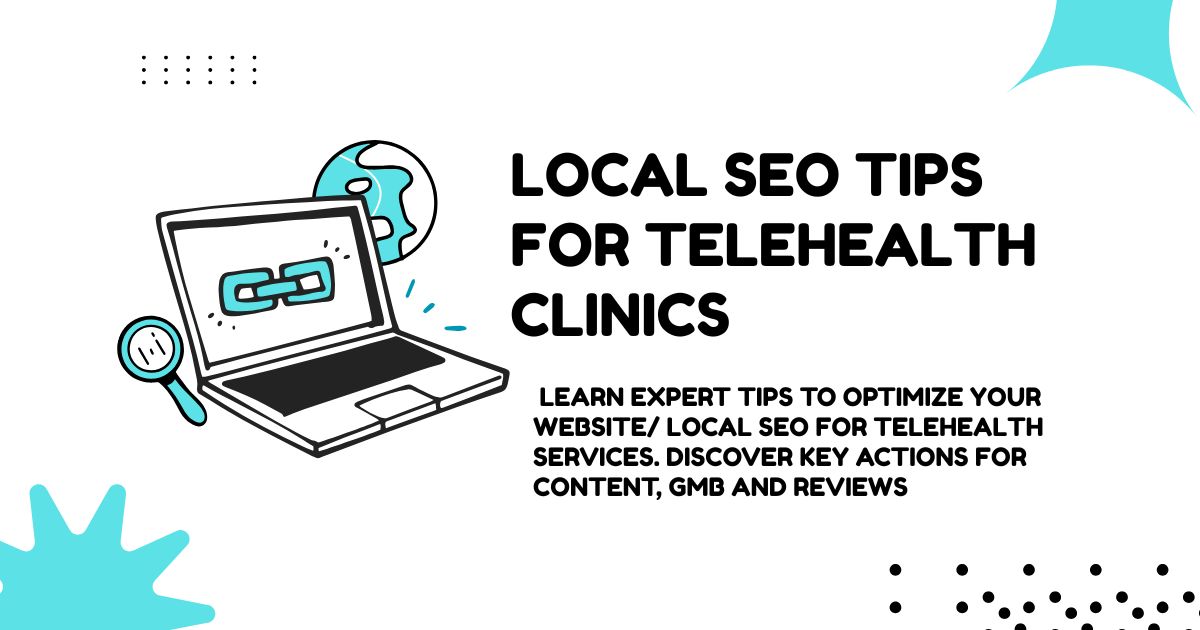
Telehealth has revolutionized healthcare delivery, but many providers struggle to attract local patients through online search. While your services may be virtual, your patients are real people living in specific communities who need to find you online.
Local SEO bridges the gap between your telehealth services and the patients in your area who need them most. This guide provides 12 actionable strategies to help your telehealth clinic dominate local search results and connect with more patients in your community.
Why Local SEO Matters for Telehealth Clinics
Local discovery makes health decisions. Even when patients want virtual care, they often prefer suppliers who understand the health challenges in society, accept local insurance plans and work in known time areas.
Search engines recognize this priority. Google shows local results for the health care system, even when users detect “online” or “virtual” services. I see patients searching for “telecommunications services” or “virtual medical appointments”, see location -based results that prefer suppliers nearby.
The local SEO also creates confidence. Patients feel more confident who serve society, show local addresses and understand regional health problems. This confidence is translated into high conversion frequencies and long -term patient conditions.
1. Optimize Your Google My Business Profile
Your Google My Business (GMB) profile acts as your digital store for local discoveries. Complete each section with accurate, detailed information about your Telehland services.
Include your business name, address, phone number and URL. Even if you do not have a physical waiting room, enter your business address to establish a local look. Add an hour surgery with any extended accessibility of telehaal.
Write a compelling business details that postpone your telecommunications health specialties and service fields. “Use Telehealth Clinic”, “Virtual Consultation” and your specific medical specialties as keywords. Examples: “Family medicine serves Austin residents with telecommunications clinic, virtual counseling, chronic disease management and immediate care services.”
Add high quality images of your medical team, office space and technology setup. These images make your practice human and incorporate the patient’s confidence in your virtual services.
2. Target Location-Specific Keywords
Research keywords for telehealth that combine your services with local identifiers. Start with broad terms like “telehealth [city name]” or “virtual doctor [state]” before targeting specific conditions and specialties.
Focus on service-area keywords that reflect how patients actually search. Examples include:
- “telehealth services Denver”
- “virtual urgent care Colorado”
- “online psychiatrist Boulder”
- “telemedicine family doctor”
Use keyword research tools to identify search volume and competition levels for your target terms. Long-tail keywords like “virtual dermatology consultation Denver” often have lower competition and higher conversion potential.
Create separate pages for different service areas if you serve multiple cities or regions. This allows you to optimize content for marketing for specific locations while avoiding keyword cannibalization.
3. Create Location-Specific Landing Pages
Develop dedicated pages for each geographic area you serve. These pages should address local health concerns, insurance plans, and regulatory requirements specific to each region.
Structure your location pages with clear headings that include your target keywords. For example:
- H1: “Telehealth Services in [City Name]”
- H2: “Virtual Care for [City] Residents”
- H3: “Common Health Conditions We Treat”
Include local health statistics and trends when relevant. A telehealth clinic serving areas with high diabetes rates might emphasize virtual diabetes management services and local prevention programs.
Add location-specific testimonials and patient success stories. Real experiences from local patients build credibility and improve search rankings through user-generated content.
4. Optimize for “Near Me” Searches
Voice search and mobile usage drive “near me” query growth. Optimize your content for phrases like “telehealth near me,” “virtual doctor near me,” and “online medical consultation nearby.”
Include natural language variations of these terms throughout your content. Instead of just targeting “telehealth near me,” create content that answers questions like “Where can I find telehealth services near me?” or “What virtual medical services are available in my area?”
Ensure your contact information appears consistently across all pages. Search engines use this information to determine your relevance for location-based queries.
Create FAQ sections that address common “near me” questions. Topics might include service areas, insurance coverage by region, and technology requirements for virtual visits.
5. Build Local Citations and Directory Listings

Consistent citations across local directories signal credibility to search engines. Submit your telehealth clinic to healthcare-specific directories and local business listings.
Focus on authoritative healthcare directories like:
- Healthgrades
- WebMD Provider Directory
- Zocdoc
- Psychology Today (for mental health services)
Ensure your Name, Address, and Phone number (NAP) information remains identical across all listings. Inconsistent information confuses search engines and hurts local rankings.
Include your specialties and service descriptions in directory profiles. Use relevant keywords naturally while providing valuable information for potential patients.
Read about Complete SEO Guide
6. Encourage and Manage Patient Reviews
Patient reviews significantly impact local search rankings and patient decision-making. Develop a systematic approach to requesting reviews from satisfied patients.
Send follow-up emails after successful virtual consultations asking for feedback. Include direct links to your Google My Business profile and other review platforms to simplify the process.
Respond to all reviews professionally and promptly. Thank patients for positive feedback and address concerns raised in negative reviews. This demonstrates your commitment to patient satisfaction.
Monitor reviews across multiple platforms including Google, Yelp, Facebook, and healthcare-specific sites. Consistent positive feedback across platforms strengthens your local SEO profile.
7. Leverage Local Schema Markup
Schema markup helps search engines understand your telehealth services and location information. Implement healthcare-specific schema to improve your chances of appearing in rich snippets and local search results.
Use LocalBusiness schema to mark up your business information, including name, address, phone number, and hours of operation. Add MedicalOrganization schema to highlight your healthcare credentials and specialties.
Include physician schema for individual doctors in your practice. This markup can display doctor information, credentials, and specialties directly in search results.
Implement FAQ schema for common telehealth questions. This markup can help your content appear in featured snippets for relevant queries.
8. Create Locally-Relevant Content
Develop content that addresses health concerns specific to your geographic area. Research local health trends, seasonal conditions, and community health challenges.
Write blog posts about topics like:
- “Managing Seasonal Allergies: Virtual Care Options for [City] Residents”
- “Telehealth Solutions for [State] Insurance Plans”
- “Winter Health Tips: Virtual Consultations for Cold Weather Conditions”
Cover local health events, awareness campaigns, and preventive care initiatives. This content demonstrates your connection to the community while targeting location-specific keywords.
Address regulatory considerations specific to your service areas. Telehealth regulations vary by state, so create content that explains your services within local legal frameworks.
9. Optimize for Mobile and Voice Search
Mobile adaptation is important for local SEO success. Many patients detect Telehaalth services on smartphones, especially when immediate care or end struggle demands.
Make sure your site is quickly loaded on mobile devices. Slow loading time hurts both user experience and searcherings. Compress images, reduce the code and use material delivery networks to improve performance.
Design Mobile -friendly appointments booking system. Patients should be able to plan virtual consultation easily from the phone without complex navigation or long forms.
Optimize voice searches by incorporating converted keywords and question -based sentences. People often use voice searches to ask questions like “Where can I find a virtual doctor?” Or “How do I make a Telehland Agreement?”
10. Partner with Local Healthcare Organizations
Building relationships with local healthcare organizations strengthens your community presence and creates valuable link-building opportunities.
Connect with local hospitals, clinics, and medical groups for referral partnerships. These relationships often result in backlinks from high-authority healthcare websites.
Participate in community health initiatives and local medical associations. Active community involvement generates local media coverage and social media mentions that boost your local SEO profile.
Consider guest posting opportunities on local healthcare blogs or medical practice websites. Share your expertise on telehealth topics while earning valuable local backlinks.
11. Track Local Search Performance
Monitor your local SEO progress using tools like Google Search Console, Google Analytics, and local SEO tracking software. Focus on metrics that directly impact patient acquisition.
Track keyword rankings for your target location-based terms. Monitor improvements in search visibility for queries like “telehealth [city name]” and condition-specific local searches.
Analyze Google My Business insights to understand how patients find your listing. Monitor metrics like search views, website clicks, and direction requests.
Measure the conversion rate from local search traffic to appointment bookings. This data helps you understand which local SEO strategies generate the most valuable patient leads.
12. Stay Current with Local Health Trends
Keep the content fresh and relevant by being informed of local health development. Monitor health patterns in society, seasonal disease patterns and new health problems in your service fields.
Update your content regularly to reflect today’s health trends and the patient’s needs. A Telehaalth clinic can create timely content on the prevention of the flu during the high season or virtual mental health care during stressful social events.
Local health is involved in discussions about news and social media. Share valuable insights about health people in society increasing your visibility and establishing idea management in your local market.
Building Your Local Telehealth Presence

Local SEO success for doctors requires frequent effort and strategic implementation. Start by customizing Google my business profile and creating site -specific materials that address your health health requirements.
Focus on making real connections with your local health services by providing valuable virtual care services. Search engines reward businesses that show authentic local engagement and expertise.
Remember that local SEO is a continuous process. Update your content regularly, monitor the performance matrix, and customize your strategy based on the patient’s needs and search engine.
Your Telehealth Clinic has an opportunity to serve patients who cannot provide traditional health services. By implementing these local SEO strategies, you will create a strong online look that connects to patients who need as much of your virtual care services as possible.


















No Comments